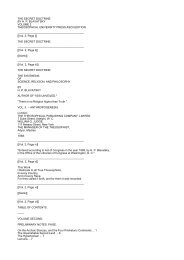You also want an ePaper? Increase the reach of your titles
YUMPU automatically turns print PDFs into web optimized ePapers that Google loves.
The Gods Of The <strong>Book</strong> Of The <strong>Dead</strong>.<br />
<strong>the</strong> doctrine <strong>of</strong> immortality, gained through <strong>the</strong> god who was "lord <strong>of</strong> <strong>the</strong> heavens and <strong>of</strong> <strong>the</strong> earth, <strong>of</strong> <strong>the</strong><br />
underworld and <strong>of</strong> <strong>the</strong> waters, <strong>of</strong> <strong>the</strong> mountains, and <strong>of</strong> all which <strong>the</strong> sun goeth round in his course,"[1]<br />
had remained unchanged for at least four thousand years <strong>of</strong> its existence.<br />
Auset or Isis, <strong>the</strong> seventh member <strong>of</strong> <strong>the</strong> company <strong>of</strong> <strong>the</strong> gods <strong>of</strong> Annu, was <strong>the</strong> wife <strong>of</strong> Osiris and <strong>the</strong><br />
mo<strong>the</strong>r <strong>of</strong> Horus; her woes have been described both by Egyptian and Greek writers.[2] Her commonest<br />
names are "<strong>the</strong> great goddess, <strong>the</strong> divine mo<strong>the</strong>r, <strong>the</strong> mistress <strong>of</strong> charms or enchantments"; in later times<br />
she is called <strong>the</strong> "mo<strong>the</strong>r <strong>of</strong> <strong>the</strong> gods," and <strong>the</strong> "living one." She is usually depicted in <strong>the</strong> form <strong>of</strong> a<br />
woman, with a head-dress in <strong>the</strong> shape <strong>of</strong> a seat, <strong>the</strong> hieroglyphic for which forms her name. The animal<br />
sacred to her was <strong>the</strong> cow, hence she sometimes wears upon her head <strong>the</strong> horns <strong>of</strong> that animal<br />
accompanied by plumes and fea<strong>the</strong>rs. In one aspect she is identified with <strong>the</strong> goddess Selk or Serq, and<br />
she <strong>the</strong>n has upon her head a scorpion, <strong>the</strong> emblem <strong>of</strong> that goddess;[3] in ano<strong>the</strong>r aspect she is united to<br />
<strong>the</strong> star Sothis, and <strong>the</strong>n a star is added to her crown. She is, however, most commonly represented as <strong>the</strong><br />
mo<strong>the</strong>r suckling her child Horus, and figures <strong>of</strong> her in this aspect, in bronze and faïence, exist in<br />
thousands. As a nature goddess she is seen standing in <strong>the</strong> boat <strong>of</strong> <strong>the</strong> sun, and she was probably <strong>the</strong> deity<br />
<strong>of</strong> <strong>the</strong> dawn.<br />
Heru or Horus, <strong>the</strong> sun-god, was originally a totally distinct god from Horus, <strong>the</strong> son <strong>of</strong> Osiris and Isis,<br />
but from <strong>the</strong> earliest times it seems that <strong>the</strong> two gods were confounded, and that <strong>the</strong> attributes <strong>of</strong> <strong>the</strong> one<br />
were ascribed to <strong>the</strong> o<strong>the</strong>r; <strong>the</strong> fight which Horus <strong>the</strong> sun-god waged against night and darkness was also<br />
at a very early period identified with <strong>the</strong> combat between Horus, <strong>the</strong> son <strong>of</strong><br />
[1. ###.<br />
2. Chabas, Un Hymne à Osiris (in Revue Archéologique, t. xiv., p. 65 ff.); Horrack, Les Lamentations d'Isis et de Nephthys,<br />
Paris, 1866; The Festival Songs <strong>of</strong> Isis and Nephthys (in Archæologia, vol. lii., London, 1891), etc.<br />
3 See Lanzone, op. cit., tav. 306 ff.]<br />
{p. cxv}<br />
Isis, and his bro<strong>the</strong>r Set. The visible emblem <strong>of</strong> <strong>the</strong> sun-god was at a very early date <strong>the</strong> hawk is, which<br />
was probably <strong>the</strong> first living thing worshipped by <strong>the</strong> early Egyptians; already in <strong>the</strong> pyramid texts <strong>the</strong><br />
hawk on a standard is used indiscriminately with ### to represent <strong>the</strong> word "god." The principal forms <strong>of</strong><br />
Horus <strong>the</strong> sun-god, which probably represent <strong>the</strong> sun at various periods <strong>of</strong> <strong>the</strong> day and night,<br />
are:--Heru-ur ({Greek A?rwh`rei), "Horus <strong>the</strong> Great"; Heru-merti, "Horus <strong>of</strong> <strong>the</strong> two eyes," i.e., <strong>of</strong> <strong>the</strong><br />
sun and moon;[1] Heru-nub, "<strong>the</strong> golden Horus"; Heru-khent-khat; Heru-khent-an-maa, "Horus dwelling<br />
in blindness"; Heru-khuti, "Horus <strong>of</strong> <strong>the</strong> two horizons,"[2] <strong>the</strong> type <strong>of</strong> which on earth was <strong>the</strong> Sphinx;<br />
Heru-sam-taui, "Horus <strong>the</strong> uniter <strong>of</strong> <strong>the</strong> north and south"; Heru-hekenu, " Horus <strong>of</strong> Heken"; and<br />
Heru-behutet, "Horus <strong>of</strong> Behutet."[3] The cippi <strong>of</strong> Horus, which became so common at a late period in<br />
Egypt, seem to unite <strong>the</strong> idea <strong>of</strong> <strong>the</strong> physical and moral conceptions <strong>of</strong> Horus <strong>the</strong> sun-god and <strong>of</strong> Horus<br />
<strong>the</strong> son <strong>of</strong> Osiris and Isis.<br />
Horus, <strong>the</strong> son <strong>of</strong> Osiris and Isis, appears in Egyptian texts usually as Heru-p-khart, " Horus <strong>the</strong> child,"<br />
who afterwards became <strong>the</strong> "avenger <strong>of</strong> his fa<strong>the</strong>r Osiris," and occupied his throne, as we are told in<br />
many places in <strong>the</strong> <strong>Book</strong> <strong>of</strong> <strong>the</strong> <strong>Dead</strong>. In <strong>the</strong> pyramid texts <strong>the</strong> deceased is identified with Heru-p-khart,<br />
and a reference is made to <strong>the</strong> fact that <strong>the</strong> god is always represented with a finger in his mouth.[4] The<br />
curious legend which Plutarch relates concerning Harpocrates and <strong>the</strong> cause <strong>of</strong> his lameness' is probably<br />
[1. A very interesting figure <strong>of</strong> this god represents him holding his eyes in his hands; see Lanzone, op. cit., p. 618.<br />
http://www.sacred-texts.com/egy/ebod/ebod09.htm (6 <strong>of</strong> 19) [8/10/2001 11:23:59 AM]

















